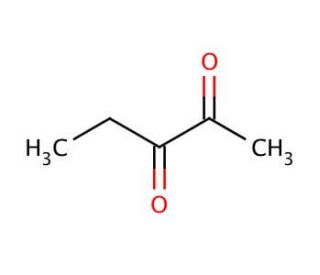

2,3-Pentanedione (CAS 600-14-6)
QUICK LINKS
2,3-Pentanedione is a chemical compound that functions as an agent and fragrance ingredient in various applications. It interacts at the molecular level by forming covalent bonds with other compounds, contributing to the aroma and taste profile of the experimental products. Its mechanism of action involves binding to specific receptors in sensory cells, triggering a cascade of biochemical reactions that result in the perception of a distinct scent. 2,3-Pentanedione plays a role in experimental studies aimed at understanding the sensory properties of different substances and their potential applications in various consumer products. Its function as a fragrance ingredient is integral to the investigation of chemical composition and sensory characteristics of experimental formulations, contributing to the understanding of fragrance science.
2,3-Pentanedione (CAS 600-14-6) References
- Atmospheric chemistry of 2,3-pentanedione: photolysis and reaction with OH radicals. | Szabó, E., et al. 2011. J Phys Chem A. 115: 9160-8. PMID: 21786774
- Respiratory and olfactory cytotoxicity of inhaled 2,3-pentanedione in Sprague-Dawley rats. | Hubbs, AF., et al. 2012. Am J Pathol. 181: 829-44. PMID: 22894831
- Diacetyl and 2,3-pentanedione exposures associated with cigarette smoking: implications for risk assessment of food and flavoring workers. | Pierce, JS., et al. 2014. Crit Rev Toxicol. 44: 420-35. PMID: 24635357
- Diacetyl and 2,3-pentanedione exposure of human cultured airway epithelial cells: Ion transport effects and metabolism of butter flavoring agents. | Zaccone, EJ., et al. 2015. Toxicol Appl Pharmacol. 289: 542-9. PMID: 26454031
- Chemical Reactivity and Respiratory Toxicity of the α-Diketone Flavoring Agents: 2,3-Butanedione, 2,3-Pentanedione, and 2,3-Hexanedione. | Morgan, DL., et al. 2016. Toxicol Pathol. 44: 763-83. PMID: 27025954
- Increased sensitivity of OSHA method analysis of diacetyl and 2,3-pentanedione in air. | LeBouf, R. and Simmons, M. 2017. J Occup Environ Hyg. 14: 343-348. PMID: 27792470
- Diacetyl and 2,3-pentanedione in breathing zone and area air during large-scale commercial coffee roasting, blending and grinding processes. | McCoy, MJ., et al. 2017. Toxicol Rep. 4: 113-122. PMID: 28959632
- Small molecule diketone flavorants diacetyl and 2,3-pentanedione promote neurotoxicity but inhibit amyloid β aggregation. | Das, S. and Smid, SD. 2019. Toxicol Lett. 300: 67-72. PMID: 30381254
- Potential Hazards Not Communicated in Safety Data Sheets of Flavoring Formulations, Including Diacetyl and 2,3-Pentanedione. | LeBouf, RF., et al. 2019. Ann Work Expo Health. 63: 124-130. PMID: 30407491
- Exposures and Emissions in Coffee Roasting Facilities and Cafés: Diacetyl, 2,3-Pentanedione, and Other Volatile Organic Compounds. | LeBouf, RF., et al. 2020. Front Public Health. 8: 561740. PMID: 33072698
- Model Predictions of Occupational Exposures to Diacetyl and 2,3-Pentanedione Emitted From Roasted Whole Bean and Ground Coffee: Influence of Roast Level and Physical Form on Specific Emission Rates. | LeBouf, RF., et al. 2022. Front Public Health. 10: 786924. PMID: 35400070
- Case Study: Efficacy of Engineering Controls in Mitigating Diacetyl and 2,3-Pentanedione Emissions During Coffee Grinding. | Stanton, ML., et al. 2022. Front Public Health. 10: 750289. PMID: 35664098
- Decrements in lung function and respiratory abnormalities associated with exposure to diacetyl and 2,3-pentanedione in coffee production workers. | Virji, MA., et al. 2022. Front Public Health. 10: 966374. PMID: 36033819
- Review of evidence relating to occupational exposure limits for alpha-diketones and acetoin, and considerations for deriving an occupational exposure limit for 2,3-pentanedione. | Card, JW., et al. 2022. Crit Rev Toxicol. 52: 715-730. PMID: 36803409
Ordering Information
| Product Name | Catalog # | UNIT | Price | Qty | FAVORITES | |
2,3-Pentanedione, 25 g | sc-230863 | 25 g | $39.00 |
